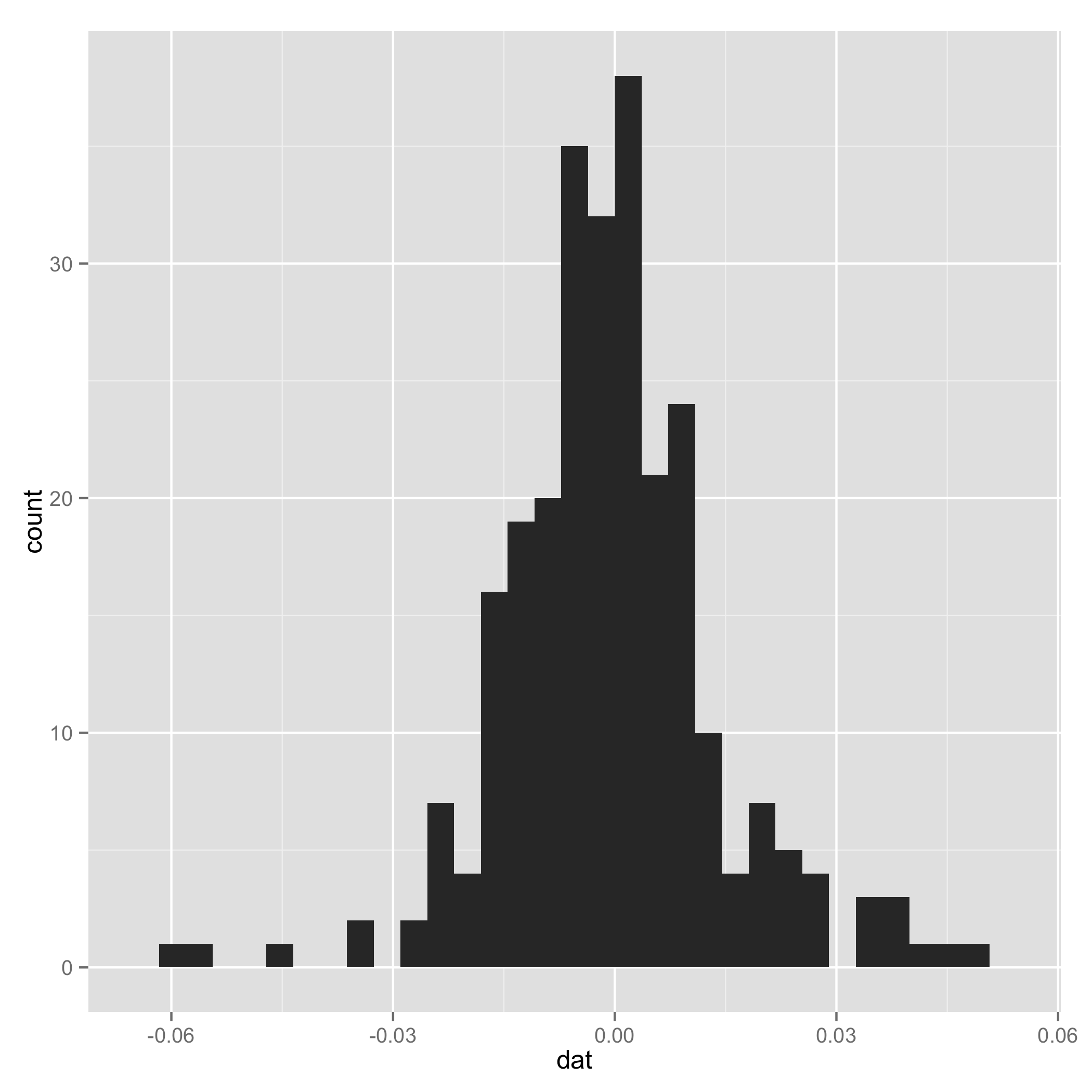I want to implement the EM algorithm manually and then compare it to the results of the normalmixEM of mixtools package. Of course, I would be happy if they both lead to the same results. The main reference is Geoffrey McLachlan (2000), Finite Mixture Models.
I have a mixture density of two Gaussians, in general form, the log-likelihood is given by (McLachlan page 48):
$$ \log L_c(\Psi) = \sum_{i=1}^g \sum_{j=1}^n z_{ij}\{\log \pi_i + \log f_i(y_i;\theta_i)\}. $$ The $z_{ij}$ are $1$, if the observation was from the $i$th component density, otherwise $0$. The $f_i$ is the density of the normal distribution. The $\pi$ is the mixture proportion, so $\pi_1$ is the probability, that an observation is from the first Gaussian distribution and $\pi_2$ is the probability, that an observation is from the second Gaussian distribution.
The E step is now, calculation of the conditional expectation:
$$ Q(\Psi;\Psi^{(0)}) = E_{\Psi(0)}\{\log L_c(|\Psi)|y\}. $$ which leads, after a few derivations to the result (page 49):
\begin{align} \tau_i(y_j;\Psi^{(k)}) &= \frac{\pi_i^{(k)}f_i(y_j;\theta_i^{(k)}}{f(y_j;\Psi^{(k)}} \\[8pt] &= \frac{\pi_i^{(k)}f_i(y_j;\theta_i^{(k)}}{\sum_{h=1}^g \pi_h^{(k)}f_h(y_j;\theta_h^{(k)})} \end{align} in the case of two Gaussians (page 82):
$$ \tau_i(y_j;\Psi) = \frac{\pi_i \phi(y_j;\mu_i,\Sigma_i)}{\sum_{h=1}^g \pi_h\phi(y_j; \mu_h,\Sigma_h)} $$ The M step is now the maximization of Q (page 49):
$$ Q(\Psi;\Psi^{(k)}) = \sum_{i=1}^g\sum_{j=1}^n\tau_i(y_j;\Psi^{(k)})\{\log \pi_i + \log f_i(y_j;\theta_i)\}. $$ This leads to (in the case of two Gaussians) (page 82):
\begin{align} \mu_i^{(k+1)} &= \frac{\sum_{j=1}^n \tau_{ij}^{(k)}y_j}{\sum_{j=1}^n \tau_{ij}^{(k)}} \\[8pt] \Sigma_i^{(k+1)} &= \frac{\sum_{j=1}^n \tau_{ij}^{(k)}(y_j - \mu_i^{(k+1)})(y_j - \mu_i^{(k+1)})^T}{\sum_{j=1}^n \tau_{ij}^{(k)}} \end{align} and we know that (p. 50)
$$ \pi_i^{(k+1)} = \frac{\sum_{j=1}^n \tau_i(y_j;\Psi^{(k)})}{n}\qquad (i = 1, \ldots, g). $$ We repeat the E, M steps until $L(\Psi^{(k+1)})-L(\Psi^{(k)})$ is small.
I tried to write a R code (data can be found here).
# EM algorithm manually
# dat is the data
# initial values
pi1 <- 0.5
pi2 <- 0.5
mu1 <- -0.01
mu2 <- 0.01
sigma1 <- 0.01
sigma2 <- 0.02
loglik[1] <- 0
loglik[2] <- sum(pi1*(log(pi1) + log(dnorm(dat,mu1,sigma1)))) +
sum(pi2*(log(pi2) + log(dnorm(dat,mu2,sigma2))))
tau1 <- 0
tau2 <- 0
k <- 1
# loop
while(abs(loglik[k+1]-loglik[k]) >= 0.00001) {
# E step
tau1 <- pi1*dnorm(dat,mean=mu1,sd=sigma1)/(pi1*dnorm(x,mean=mu1,sd=sigma1) +
pi2*dnorm(dat,mean=mu2,sd=sigma2))
tau2 <- pi2*dnorm(dat,mean=mu2,sd=sigma2)/(pi1*dnorm(x,mean=mu1,sd=sigma1) +
pi2*dnorm(dat,mean=mu2,sd=sigma2))
# M step
pi1 <- sum(tau1)/length(dat)
pi2 <- sum(tau2)/length(dat)
mu1 <- sum(tau1*x)/sum(tau1)
mu2 <- sum(tau2*x)/sum(tau2)
sigma1 <- sum(tau1*(x-mu1)^2)/sum(tau1)
sigma2 <- sum(tau2*(x-mu2)^2)/sum(tau2)
loglik[k] <- sum(tau1*(log(pi1) + log(dnorm(x,mu1,sigma1)))) +
sum(tau2*(log(pi2) + log(dnorm(x,mu2,sigma2))))
k <- k+1
}
# compare
library(mixtools)
gm <- normalmixEM(x, k=2, lambda=c(0.5,0.5), mu=c(-0.01,0.01), sigma=c(0.01,0.02))
gm$lambda
gm$mu
gm$sigma
gm$loglik
The algorithm is not working, since some observations have the likelihood of zero and the log of this is -Inf. Where is my mistake?

